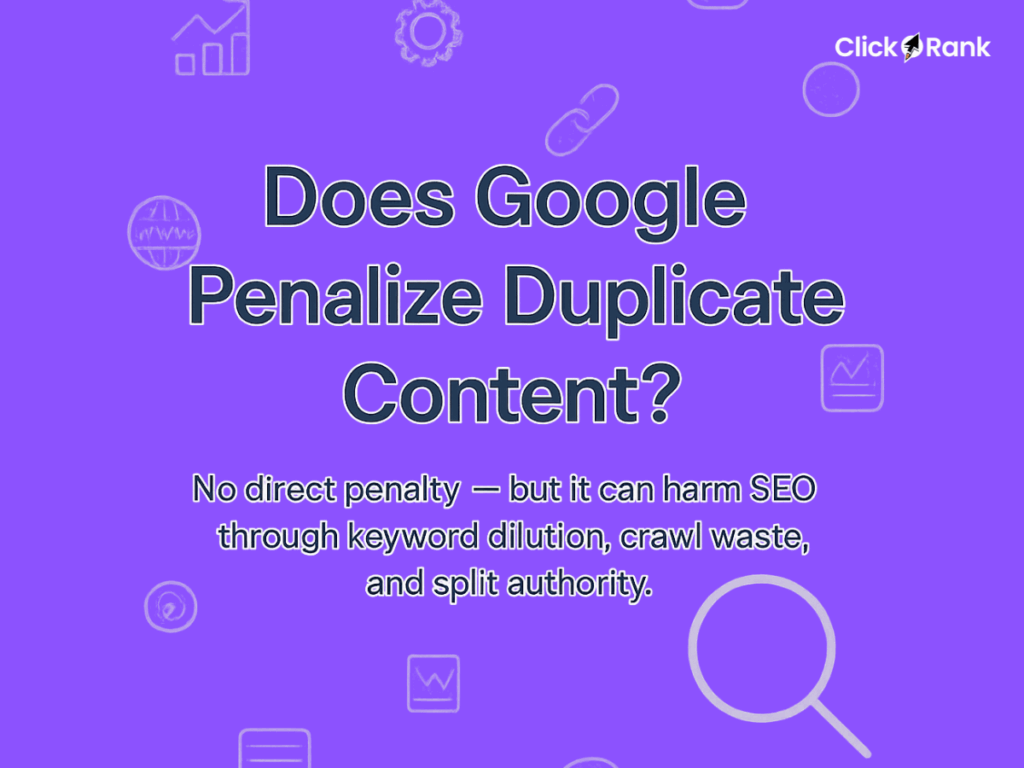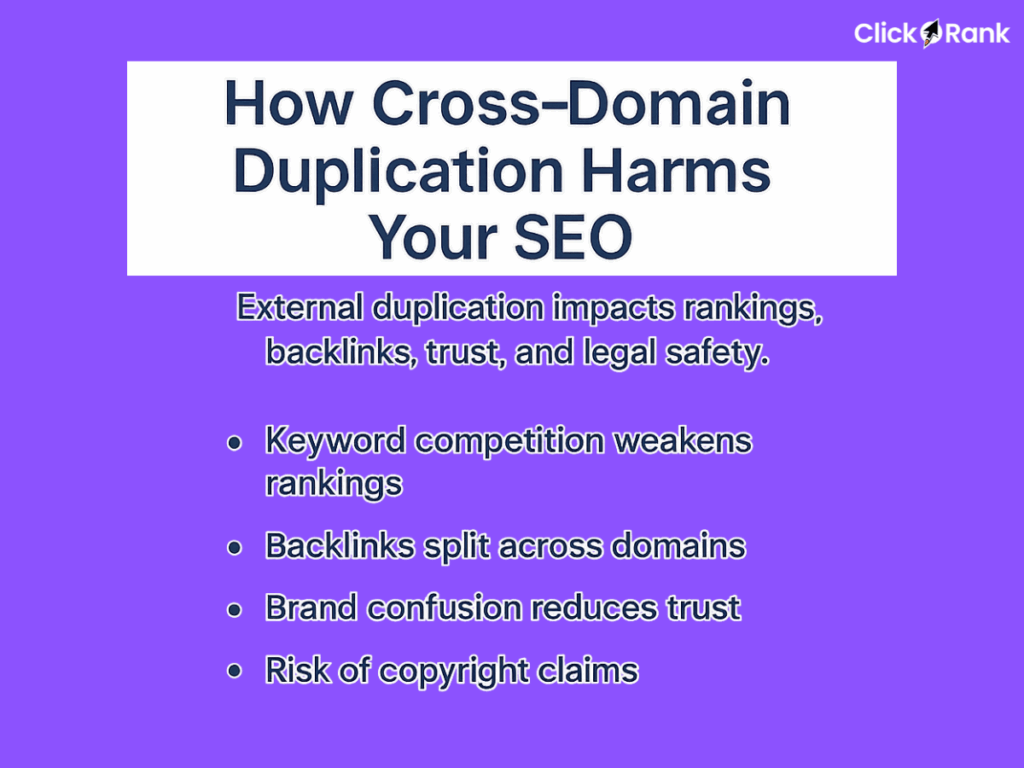You’ve spent hours on a killer piece of content, but you’re not getting the credit. That’s often a sign of cross-domain duplicate content a silent SEO killer. While duplication on your own site is one thing, content copied to other domains can confuse search engines and hurt your rankings.
This guide will show you how to fix these issues. We’ll explore the real impact of duplicate content, how to prevent it, and the best practices (like canonical links) to ensure your website maintains its visibility.
Analyze your domain's health score and fix all issues with a single click.

What Is Duplicate Content?
Duplicate content is any text, article, or webpage that appears on multiple URLs, whether on the same website or across different domains.
How It Happens
Duplicate content can happen intentionally (e.g., syndicating an article) or due to technical issues like URL variations, session IDs, or site versions (www vs. non-www).
The Two Main Types of Duplicate Content
There are two main types of duplicate content:
- Internal Duplicate Content: When similar or identical content appears on different pages within the same website, causing competition between them in search rankings.
- External Duplicate Content: When the same content exists on multiple domains, making each site compete against the other in search results.
Need Blog Topics Fast? Use our Content Idea Generator to fuel your content calendar today

Does Google Penalize Duplicate Content?
There is no direct penalty for duplicate content, but Google prioritizes unique and valuable content.
According to Google, duplicate content on a site is not grounds for action “unless it appears that the intent is to be deceptive and manipulate search engine results”.
Indirect SEO Impacts of Duplication
Even without a direct penalty, duplicate content can still hurt SEO by causing:
- Keyword dilution: Pages compete for rankings on the same terms.
- Reduced crawl efficiency: Search engines waste time indexing duplicate pages instead of unique ones.
- Lower authority: If multiple sites have the same content, backlinks and credibility get split.
How to Identify Duplicate Content
Before you can fix the problem, you need to know if you even have duplicate content in the first place. To ensure your content is unique, you can use various SEO analysis tools.
Tools to Help You Detect Duplication
- Google Search Console: Utilize the Coverage Report and URL Inspection tool to check how Google processes your content and whether duplication issues exist.
- Site Audit Tools: Platforms like Screaming Frog, Ahrefs, and Moz help detect similarities in titles, meta descriptions, subheadings, and overall content.
- Duplicate Content Checkers: Tools like Copyscape, Siteliner, and DupliChecker compare your content with other websites to identify any unauthorized copies.

How Cross-Domain Duplication Harms Your SEO
While search engines can manage internal duplicate content using canonical tags and redirects, duplication across different domains presents a bigger challenge.
The SEO Impacts of External Duplicate Content
- Keyword Competition: Duplicate content across domains competes for the same keywords, diluting search rankings and making it harder for the original source to rank.
- Loss of Backlink Authority: Backlinks may be distributed among multiple websites with the same content, reducing the original content’s authority and ranking potential.
- Brand Confusion & Lost User Trust: When consumers see identical content across multiple sites, they may struggle to distinguish between similar businesses, leading to a loss of trust, lost sales, or misdirected traffic.
- Copyright Risks: Publishing duplicate content exposes websites to copyright infringement claims, especially if content is copied from competitors.

How to Handle Duplicate Content Across Different Domains
To prevent and fix these issues, you need to implement effective solutions tailored to the nature of the duplication.
Essential Solutions for Your Website
- Select a Preferred Domain: Search engines often filter duplicate pages and choose one version to display, but it is best to explicitly define your preferred domain using proper SEO techniques.
- Implement 301 Redirects: When duplicate pages exist on different domains, 301 (permanent) redirects are the best way to consolidate them. This ensures that only one version is indexed, strengthening your website’s authority.
- Use Canonical Tags for Cross-Domain Content: If redirects are not feasible, a cross-domain
rel="canonical"tag helps specify the original source of the content. This tells search engines which URL should be treated as the primary version, helping to avoid ranking conflicts.
Proactive Content Strategies
- Reduce Internal Duplication First: Before addressing cross-domain issues, ensure that your own website does not have duplicate content by checking for identical product descriptions, URL variations, or paginated content, and consolidating pages when necessary.
- Optimize and Differentiate Content: Instead of reusing the same content across multiple domains, rewrite, expand, or tailor it to different audiences. This approach not only avoids duplication issues but also improves user engagement by offering fresh and valuable insights.
ClickRank’s Free Tools for Content & SEO
ClickRank offers a suite of free tools to help with various SEO tasks and content creation. You can access all of these on their Free Tools page.
Content Generation and Optimization Tools
- AI Keyword Tool: Generate SEO-friendly keyword suggestions tailored to your content.
- Title Tag Generator: Create optimized title tags for improved SERP visibility.
- Image Alt Text Generator: Automatically generate descriptive alt text for images to boost accessibility and SEO.
- Meta Description Generator: Produce compelling meta description copy to increase click-through rates.
- AI Rewording Tool: Rewrite text to improve clarity, tone, and originality.
- AI Summarizer Tool: Condense longer articles or documents into concise summaries.
- AI Text Humanizer: Transform AI-generated text into more natural, audience-friendly prose.
- AI Content Idea Generator: Generate blog post, article, or social media content ideas instantly.
Other Useful Tools
- AI Paragraph Generator: Generate unique, high-quality paragraphs on demand for writing support.
- AI Acronym Generator: Create catchy, memorable acronyms instantly for projects or brands.
- AI Business Name Generator: Brainstorm brand or business names using AI-powered creativity.
- AI Brand Name Generator: Generate unique brand names powered by AI.
- AI Lorem Ipsum Generator: Create realistic filler text for design mockups and layouts.
Final Thoughts
Managing duplicate content across different domains is crucial for maintaining your site’s SEO performance and credibility. By implementing the right strategies, such as canonical tags, 301 redirects, and content optimization, you can prevent ranking issues and ensure your original content gets the visibility it deserves. It’s a proactive approach that helps keep your website in top shape.

FAQs
What is duplicate content across different domains in SEO?
Duplicate content across different domains occurs when identical or highly similar content appears on two or more websites. This can confuse search engines, leading to lower rankings for all versions, as Google struggles to determine which page is the original or most relevant.
Does Google penalize duplicate content across domains?
Google does not directly penalize duplicate content unless it’s used deceptively to manipulate rankings. However, it can still harm SEO by splitting link equity, reducing visibility, and making it harder for the original source to rank above duplicate versions.
How can I check if my content is duplicated on other websites?
You can check for cross-domain duplicate content using tools like Copyscape, Siteliner, or Ahrefs Site Explorer. Simply enter your page URL, and these tools will scan the web to detect identical or highly similar text appearing on other domains.
How do I fix duplicate content across different domains?
The best solutions include adding a cross-domain rel=canonical tag, implementing 301 redirects, or rewriting content to make it unique. If you can’t remove the duplicate version, using a noindex tag can prevent it from being indexed by search engines.
Can I use the same blog post on two different websites?
You can, but it’s not ideal for SEO. Publishing the same blog post on two websites may cause keyword competition between them, reducing rankings for both. If reuse is necessary, add a canonical tag to signal the preferred source to search engines.
Why is duplicate content across domains bad for SEO?
It’s bad for SEO because it dilutes keyword rankings, splits backlink authority, and can confuse both search engines and users. This can lead to lower organic visibility, reduced traffic, and weaker brand credibility compared to having unique, original content.



Cuál es la diferencia principal entre las etiquetas H1,H5?
Las etiquetas H1 y H5 son parte de la jerarquía de encabezados HTML que estructuran el contenido de una página web. H1 se utiliza para el título principal de la página y debe ser único, destacando el tema principal. Tiene el mayor peso SEO y ayuda a los motores de búsqueda a entender de qué trata la página. H5, en cambio, es un subtítulo de menor jerarquía, útil para dividir secciones dentro de contenido más detallado o complejo. Aunque H5 tiene menos peso SEO que H1, seguir una estructura jerárquica correcta mejora la legibilidad, experiencia del usuario y optimización para motores de búsqueda.